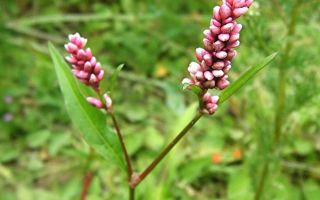Content
The beneficial properties of the mountaineer pochechuy and contraindications are of interest to connoisseurs of traditional medicine. The plant helps with many ailments, but requires caution when applied.
What it looks like and where it grows
Pochuychny Knotweed (Polygonum persicaria) is a herbaceous plant up to 60 cm tall with a one-year life cycle. Possesses bare straight stems of reddish color, rising in the lower part, with nodes without thickenings. The leaves of the plant are lanceolate or linear, with a wedge-shaped base, arranged in regular order. In color, the plates are green above and grayish at the bottom, often covered with dark spots.
From July to September, the highlander produces small pink or whitish buds, collected in dense spikelets up to 3 cm long. At the end of flowering, it produces fruits - dark shiny ovoid nuts.
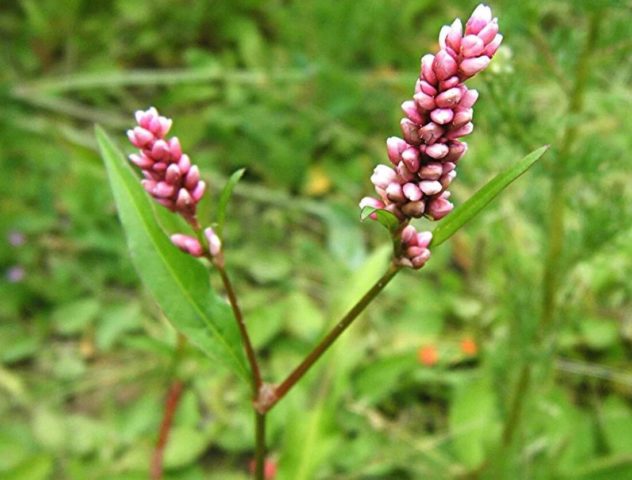
Knotweed is widespread in Europe and Asia, as well as in North America as an invasive plant. In Russia, you can find it in the Far East and southern Siberia, in the central regions and in the Caucasus. For life, the plant chooses damp places - the shores of lakes and rivers, ditches and meadows, roadside ravines. Sometimes found in the form of a weed in fields and gardens.
Chemical composition
The benefits and harms of the mountaineer are due to its composition. The leaves and roots of the plant contain:
- quercetin and kaempferol;
- gallic and malic acids;
- flavonoids;
- copper, selenium and zinc;
- anthraquinones;
- vitamins C and K;
- essential oils and tannins;
- pectins;
- rutin;
- hyperoside and hyperin;
- acetic and oxalic acids;
- florabens;
- mucus and sugar;
- wax.
It is impossible to consume large amounts of Knotweed because of the high concentration of active substances. But even in small dosages, drugs based on it have a pronounced medicinal effect.
Useful properties of highlander pochechuyny
In folk medicine, the knotweed is used both fresh and dried. The plant has a beneficial effect on the body and helps with diseases. Namely:
- constricts blood vessels and regulates blood pressure;
- promotes healing of injuries and stops bleeding;
- has a diuretic and laxative effect;
- increases blood viscosity and improves its composition;
- strengthens the gums;
- helps fight inflammation and infectious processes;
- relieves itching for skin ailments.
Especially often, the mountaineer is used to treat hemorrhoids. Herbal remedies stop bleeding and promote resorption of nodes, relieve pain and discomfort in the anus.
Useful properties of highlander pochechuyny for women
The properties of the knotweed are beneficial for uterine bleeding in women. The plant reduces the volume of secretions during heavy periods, makes them less painful and prevents the development of anemia and weakness. The anti-inflammatory properties of the herb help fight inflammation in the pelvis and restore a disturbed cycle.
Preparation and application methods
Traditional medicine prepares water decoctions, infusions and alcohol products on the basis of the mountaineer. They can be used not only internally, but also externally.
Pochechuyny Highlander tincture
Strong tincture of the plant has a good effect on diseases of the liver and gallbladder. Make a tool according to this algorithm:
- The roots and leaves of the plant are crushed in a volume of 10 g.
- Pour raw materials with 200 ml of alcohol or vodka.
- Shake the container and remove it in a dark place for ten days.
The strained tincture is taken three times a day, 20 drops. First, the product must be diluted in 100 ml of pure water.
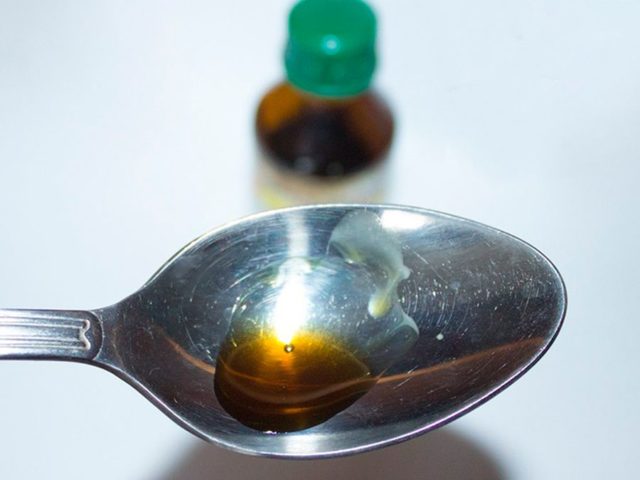
Infusion
An aqueous infusion of the herb of the knotweed is beneficial for intestinal disorders and a tendency to edema. Do the medicine like this:
- Measure out two large tablespoons of the dried herb of the plant.
- Steamed with a glass of hot liquid.
- In a closed thermos, insist for two hours and filter.
Take the drug 30 ml three times a day on an empty stomach.
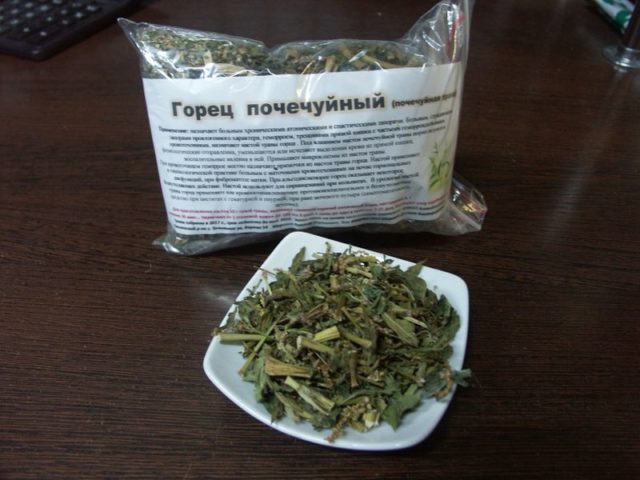
Decoction
The beneficial properties of Polygonum persicaria are used for hemorrhoids and intestinal ailments to relieve inflammation and stop bleeding. The recipe looks like this:
- About 20 g of dry or fresh grass is poured into 250 ml of hot water.
- Warm up over low heat for 20 minutes.
- Leave under the lid to cool and filter.
You need to drink the broth after meals up to three times a day, a large spoonful.
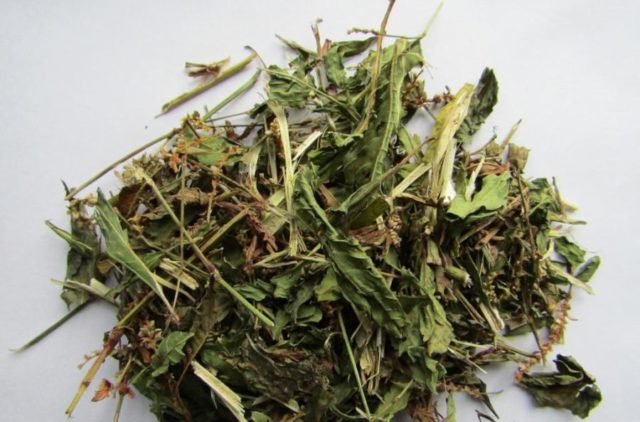
Compresses, baths
For wounds and cuts, as well as for hemorrhoids, the highlander is recommended to be used externally. Compresses are applied to the nodes in the anus, and they are done like this:
- A simple infusion of the plant is prepared in a thermos.
- A sterile piece of tissue is moistened in a warm medium.
- Apply to the sore spot for half an hour.
It is necessary to carry out procedures at least twice a day.
In case of external hemorrhoids, sit-down baths with a highlander are also recommended for use. They are prepared like this:
- Pour 250 g of dry grass into an enamel container and pour 5 liters of water.
- Bring to a boil over low heat and turn off immediately.
- Remove from stove and cool to a comfortable temperature.
- Strain the broth and pour it into a wide, but shallow basin.
- They are lowered into a container with the lower body for 20 minutes.
It is recommended to carry out procedures twice a day. The anus after them is gently blotted with a towel and lubricated with nourishing cream.
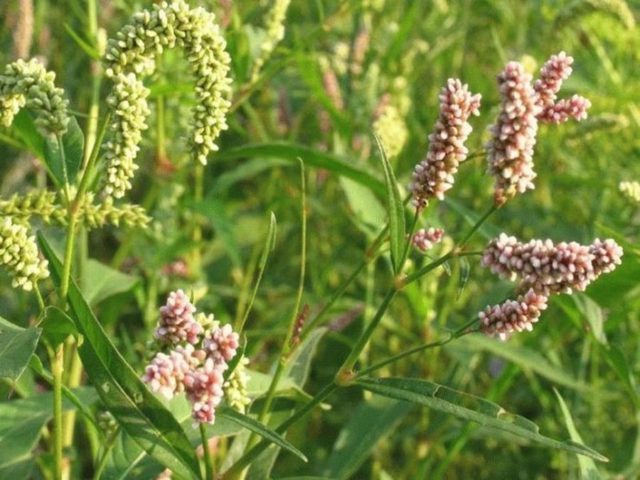
Ointments
In case of skin inflammations and rashes, homemade ointments with a mountaineer bring a good effect. One of the popular recipes looks like this:
- The fresh root of the plant is washed from impurities and ground in a blender to a state of gruel.
- Vegetable juice is squeezed out of the resulting mass.
- Stir with petroleum jelly or butter in a 1: 2 ratio.
- Put in the refrigerator until it solidifies.
It is necessary to apply the ointment to the affected areas up to five times a day. For a more pronounced effect, the treated areas are covered with a bandage.
Another option for the ointment is to take green parts of the herb for its preparation.The algorithm is proposed as follows:
- Fresh leaves of the mountaineer are carefully chopped with a knife or interrupted in a blender.
- Mix the green mass with olive oil and melted wax in a 2: 1: 1 ratio.
- Bring to a homogeneous state and cool in the refrigerator.
Use the agent to treat irritations, cuts and inflammations several times a day.
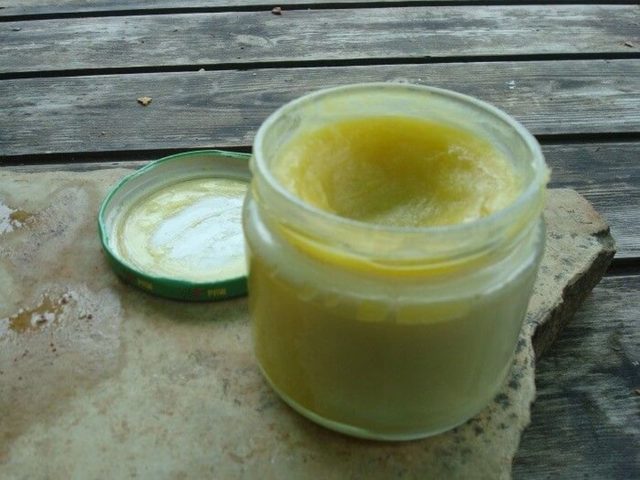
The use of highlander pochechuyny
Traditional medicine widely uses the mountaineer to combat hemorrhoids and bleeding, as well as for digestive disorders and inflammatory processes. When using medicinal products, it is necessary to follow proven schemes and dosages.
The use of kidney grass for hemorrhoids
Traditional medicine offers the following recipe for a decoction of the mountaineer for hemorrhoids:
- Dry grass plants are crushed in the volume of four large spoons.
- Pour raw materials with 500 ml of boiling water.
- They are sent to a water bath for 40 minutes.
- Remove from the stove and infuse until warm, and then filter.
It is necessary to take the broth inside in 100 ml during the day in between meals. In case of a complicated disease, the agent is simultaneously used for lotions to the anus.
With sluggish digestion
With slowed intestinal motility, you can use the infusion of healing mountaineer. The cooking algorithm is as follows:
- A large spoonful of chopped herbs is poured into a glass of boiling water.
- Cover the container with a lid and wrap it in towels.
- Withstand the product for two hours.
- Pass the liquid through cheesecloth and squeeze out the sediment.
The drug is taken 30 ml three times a day on an empty stomach.
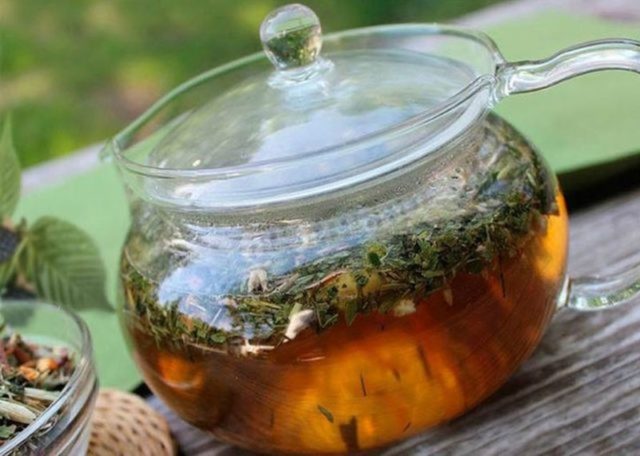
With periodontal disease
A decoction of medicinal knotweed helps with gum inflammation and bleeding. Traditional medicine recommends this recipe:
- 40 g of dry raw materials are poured into 500 ml of water.
- Put the container on low heat and simmer for 15 minutes.
- Remove from the stove and leave closed until it cools.
The strained broth is used for rinsing four times a day. Kidney grass promotes healing of mucous membranes and prevents the development of infections.
With abscesses
The herb infusion accelerates the absorption of abscesses and boils, and fights suppuration. The drug is done like this:
- Measure 5 g of chopped grass and brew with a glass of boiling water.
- Leave closed for two hours.
- Filter through cheesecloth and squeeze out the sediment.
In a warm preparation, a clean cloth is moistened and applied to the affected areas as a compress.
For wounds and cuts
Kidney herb has good healing properties. If the skin is damaged, you can use it fresh. The diagram looks like this:
- The leaves of the plant are thoroughly washed from dirt and dust.
- Grind to a state of gruel in a blender or grind in a mortar.
- Apply the resulting mass to wounds and cuts and fix with a bandage.
The fresh sap of the plant has an antiseptic effect and prevents the inflammatory process.
For constipation
A good effect for constipation is brought by enemas with a decoction of kidney herbs. The recipe for the solution looks like this:
- A usual decoction is prepared from the leaves of the plant, and then it is half-diluted with pure water.
- Stir sea salt in a warm liquid at the rate of 5 g per 1 liter of solution.
- Wait until the particles are completely dissolved.
- The finished product is introduced into the rectum using a syringe.
You need to repeat the procedures daily, and they are carried out in the evenings about an hour before bedtime.
In inflammatory processes
With any inflammation in the body, as well as with weakened immunity, you can brew tea from a healing herb. The recipe looks like this:
- Measure out three large spoons of the leaves of the plant.
- Pour dry raw materials with 250 ml of boiling water.
- Leave to infuse for 15 minutes and filter.
You need to drink tea twice a day in the volume of one glass.
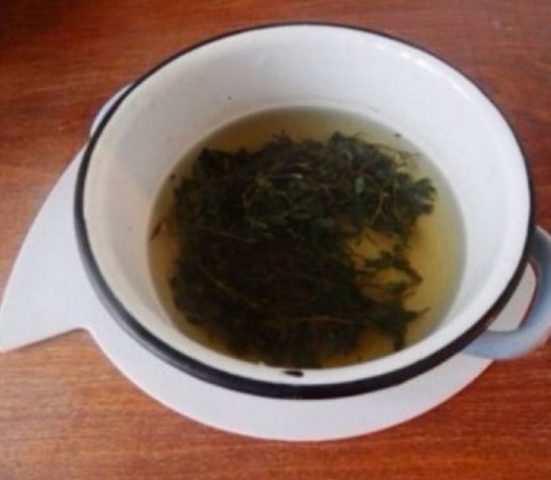
For skin diseases
For eczema and dermatitis, you can take baths with medicinal herbs. The following solution is prepared for them:
- A glass of dry finely chopped leaves is poured into 5 liters of water.
- Heat on a stove to a boil and immediately remove from heat.
- Filter the solution and cool slightly.
- Poured into a pre-filled bathing container.
You need to take healing baths every evening for 15-20 minutes. Kidney grass will help relieve severe itching and will help restore the skin.
For anal bleeding
With hemorrhoidal bleeding and rectal fissures, you can use an infusion of renal grass. The recipe is offered as follows:
- Dry grass in the amount of two large spoons is steamed with 500 ml of boiling water.
- Leave in a thermos for ten hours to infuse.
- After the expiration of the term, filter the finished product.
The infusion is taken in 50 ml during the day at short intervals. During the day, you must drink the entire volume of the drug received.
With internal hemorrhoids
Instructions for using the herb of the mountaineer advises making homemade candles based on the plant. The scheme for creating suppositories looks like this:
- A small amount of natural lard is melted over low heat.
- The product is mixed with 50 ml of the broth of the mountaineer.
- Vaseline and starch are mixed with the ingredients until a viscous and thick mass is obtained.
- Small rectal suppositories are formed and sent to the refrigerator until solidification.
It is necessary to inject suppositories into the rectum before bedtime. The therapy is continued until the patient feels better.
Contraindications to the use of highlander pochechuyny
The medicinal properties and contraindications of the herb are determined individually. It is necessary to abandon the plant:
- with jade;
- with hypertension;
- with ischemic heart disease;
- with acute inflammatory processes and large kidney stones;
- during pregnancy and lactation;
- with individual allergies;
- with varicose veins and thrombophlebitis.
When using a medicinal herb, dosages must be carefully observed. In excessive quantities, highlander leads to constipation, and also provokes excessive blood thickening.
When and how can you collect a highlander?
The harvesting of plant stems and leaves is carried out from July to the end of September. It is necessary to cut off the upper shoots at a distance of about 25 cm from the ground level. The roots of the Pochuy Knotweed are dug up in the middle of autumn, when the plant retires, and all valuable substances are concentrated in the underground part.
The collected raw materials are dried under a canopy outdoors or in a warm room with good ventilation. You can also use an electric dehydrator, setting the temperature to no more than 45 ° C. Properly harvested grass should retain its green hue. After the moisture has evaporated, the knotweed is packaged in paper bags or cardboard boxes and put away in a dark, dry place.
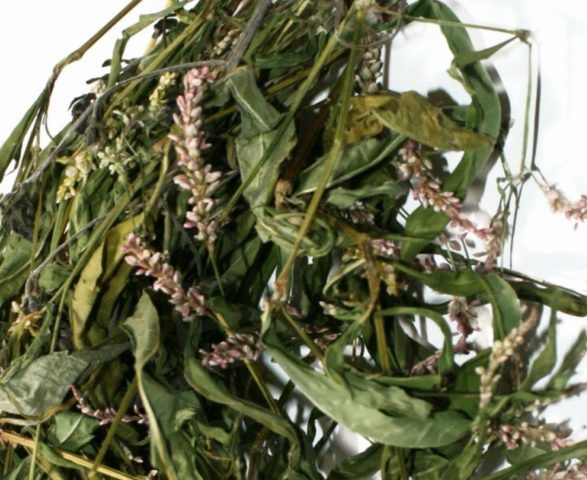
Conclusion
The useful properties of the mountaineer pochechuyny and contraindications are related to each other. The herb is used for hemorrhoids and bleeding - it has a quick healing effect. But in high dosages, the plant can lead to the formation of blood clots, which is a health hazard.

